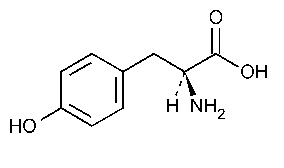Tyrosine
»Tyrosine contains not less than 98.5percent and not more than 101.5percent of C9H11NO3,as L-tyrosine,calculated on the dried basis.
Packaging and storage—
Preserve in well-closed containers.
Identification,Infrared Absorption á197Kñ.
Specific rotation á781Sñ:
between -9.8 and -11.2
and -11.2 .
.
Test solution:
50mg per mL,in 1Nhydrochloric acid.
Loss on drying á731ñ—
Dry it at 105 for 3hours:it loses not more than 0.3%of its weight.
for 3hours:it loses not more than 0.3%of its weight.
Residue on ignition á281ñ:
not more than 0.4%.
Chloride á221ñ—
Asolution containing 0.35g shows no more chloride than corresponds to 0.20mLof 0.020Nhydrochloric acid (0.04%).[NOTE—If necessary,dissolve the test specimen by heating to near boiling and adding 1mLof nitric acid.]
Sulfate á221ñ—
Asolution containing 1.2g shows no more sulfate than corresponds to 0.50mLof 0.020Nsulfuric acid (0.04%).[NOTE—If necessary,dissolve the test specimen by heating to near boiling and adding 1mLof 3Nhydrochloric acid.]
Heavy metals,Method IIá231ñ:
0.0015%.
Chromatographic purity—
Adsorbent:
0.25-mm layer of chromatographic silica gel mixture.
Diluted ammonia solution—
Transfer 16mLof concentrated ammonia to a 100-mLvolumetric flask,and dilute with water to volume.
Test solution—
Transfer about 0.1g of Tyrosine,accurately weighed,to a 10-mLvolumetric flask,dissolve in Diluted ammonia solution,and dilute with water to volume.Apply 5µL.
Standard solution—
In a suitable flask,dissolve an accurately weighed quantity of USPL-Tyrosine RSin 1mLof Diluted ammonia solution,and dilute with water to volume to obtain a solution having a known concentration of about 0.05mg per mL.Apply 5µL.[NOTE—This solution has a concentration equivalent to about 0.5%of that of the Test solution.]
System suitability solution—
Dissolve about 10mg of USPL-Tyrosine RSand about 10mg of USPL-Phenylalanine RSin 1mLof Diluted ammonia solution,dilute with water to 25.0mL,and mix.Apply 5µL.
Spray reagent—
Dissolve 0.2g of ninhydrin in 100mLof a mixture of butyl alcohol and 2Nacetic acid (95:5).
Developing solvent system—
Prepare a mixture of isopropyl alcohol and ammonium hydroxide (70:30).
Procedure—
Proceed as directed for Thin-Layer Chromatographyunder Chromatography á621ñ.Dry the plate between 100 and 105
and 105 until the ammonia disappears completely.Spray with Spray reagent,and heat between 100
until the ammonia disappears completely.Spray with Spray reagent,and heat between 100 and 105
and 105 for about 15minutes.Examine the plate under white light.The chromatogram obtained from the System suitability solutionexhibits two clearly separated spots.Any secondary spot in the chromatogram obtained from the Test solutionis not larger or more intense than the principal spot in the chromatogram obtained from the Standard solution:not more than 0.5%of any individual impurity is found;and not more than 2.0%of total impurities is found.
for about 15minutes.Examine the plate under white light.The chromatogram obtained from the System suitability solutionexhibits two clearly separated spots.Any secondary spot in the chromatogram obtained from the Test solutionis not larger or more intense than the principal spot in the chromatogram obtained from the Standard solution:not more than 0.5%of any individual impurity is found;and not more than 2.0%of total impurities is found.
Organic volatile impurities,Method IVá467ñ:
meets the requirements.
Assay—
Transfer about 180mg of Tyrosine,accurately weighed,to a 125-mLflask,dissolve in 6mLof formic acid,add 50mLof glacial acetic acid,and titrate with 0.1Nperchloric acid VS,determining the endpoint potentiometrically.Perform a blank determination,and make any necessary correction.Each mLof 0.1Nperchloric acid is equivalent to 18.12mg of C9H11NO3.
Auxiliary Information—
Staff Liaison:Lawrence Evans,III,Ph.D.,Scientist
Expert Committee:(DSN)Dietary Supplements:Non-Botanicals
USP28–NF23Page 2003
Phone Number:1-301-816-8389
